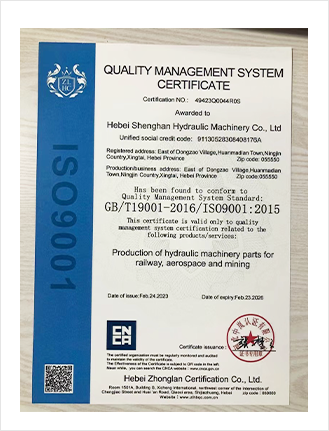Aug . 16, 2024 12:11 Back to list
Explore the Benefits of Hydraulic Gas Cylinder Solutions for Various Applications
Understanding Hydraulic Gas Cylinder Products Applications and Benefits
Hydraulic gas cylinders play an indispensable role in various industrial applications, providing controlled force and motion while ensuring safety and reliability
. Understanding these products, their mechanisms, and uses can significantly enhance their efficacy in various settings.Hydraulic gas cylinders operate by utilizing pressurized gas, usually nitrogen, which assists in retracting the cylinder rod and providing force in extension. The basic principle involves the conversion of hydraulic energy into mechanical work. This mechanism is essential in automating processes in industries ranging from manufacturing to automotive, where precise movement and controlled force are paramount.
One of the key advantages of hydraulic gas cylinders is their ability to handle substantial loads with a compact design. Unlike traditional hydraulic cylinders that rely solely on hydraulic fluid, gas cylinders can maintain pressure and force with minimal risk of leakage. This feature not only promotes efficiency but also reduces maintenance costs associated with fluid replacement and leakage repairs. The use of inert gases further contributes to the longevity and durability of these cylinders, making them ideal for harsh environments.
In terms of applications, hydraulic gas cylinders are widely used in equipment that requires lifting, lowering, or controlled movement. In the construction sector, these cylinders can be found in lifting machinery such as cranes and hydraulic excavators. Their capacity to extend and retract rapidly makes them crucial for tasks that demand quick turnaround times. Furthermore, they are also common in the automotive industry, where they assist in tasks like raising vehicles for maintenance or inspection.
hydraulic gas cylinder products

Another notable application is in the aerospace industry, where hydraulic gas cylinders are utilized in landing gear and control systems. The demands of aerospace components require these cylinders to operate reliably under extreme conditions, including wide temperature fluctuations and high pressures. Here, the lightweight nature of gas cylinders combined with their robustness makes them particularly suited for such critical roles.
Safety is a prime concern in any industry that utilizes hydraulic systems. Hydraulic gas cylinders are designed with multiple safety features, including pressure relief valves and effective seals, to prevent catastrophic failures. These safety enhancements reassure operators and enhance the overall credibility of the machines they are integrated into. Furthermore, their predictable behavior under load contributes to a reduction in accidents, offering peace of mind to users.
When integrating hydraulic gas cylinders into systems, it's essential to consider factors like load capacity, stroke length, and mounting style. Different projects may demand specific types of gas cylinders; hence, customization options are often available through manufacturers. This versatility ensures that industries can obtain a product that fits their exact needs, enhancing productivity and operational efficiency.
In conclusion, hydraulic gas cylinder products are vital components in a myriad of applications across diverse industries. Their unique functionality, coupled with inherent safety features and minimal maintenance needs, showcases their importance in modern engineering. As technology advances, the evolution of these cylinders continues, promising even greater efficiencies and capabilities in the future, making them a sound investment for companies aiming to optimize their processes and enhance operational efficiency. Whether you're in construction, automotive, or aerospace, understanding and utilizing hydraulic gas cylinders can lead to improved outcomes and streamlined operations.
-
Premium Car Tailgate Power Units Reliable OEM Solutions
NewsMay.31,2025
-
China's Premium Hydraulic Cylinders Superior Power & ISO-Certified Force
NewsMay.31,2025
-
Boarding Axle Power Units Trusted Manufacturer & Supplier
NewsMay.30,2025
-
Custom Automotive Lift Power Units High-Performance & Durable Solutions
NewsMay.30,2025
-
China Balanced Hydraulic Cylinder Manufacturer High-Performance & Durable Solutions
NewsMay.30,2025
-
Wrecker Hydraulic Cylinders Heavy-Duty & Custom Solutions
NewsMay.29,2025
